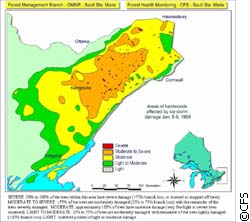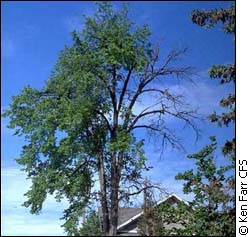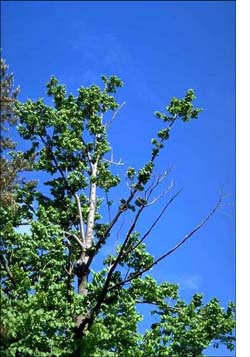| Recovering
from the storm
of the century
By Greg MacCormack
OTTAWA
— The ice storm
of 1998 is remembered as the worst ice storm on record.
Trees were damaged across Ontario, Quebec, and the Maritimes
as well as the northeastern United States.
Ontario was pelted with 85-110 millimetres
of freezing rain that would wreck the maple syrup and
wood lot industries. These industries, like the trees
they depend on, are only now recovering from the storm.
 |
| Canadan Forest Service graph
of dammaged areas. |
Forests damaged
Accumulated ice caused tree branches to
bend and eventually break off. Larger branches near
the top of trees crashed into branches below causing
them to break with a distinctive snapping sound. Wade
Knight from the Ontario Woodlot Association said the
ice storm left many trees with a “brush cut”
or crown damage. In some areas, the trunks of smaller
trees snapped from the weight of the ice.
According to Thomas Knowland, a researcher
for Natural Resources Canada, maps of damaged areas
resemble a “checkerboard.” Small changes
in elevation or exposure to wind created variations
in tree damage, even in a small stand. Knowland says
tree mortally doubled the year following the ice storm.
Ken Farr, a science advisor for Forestry
Canada, said trees with a wide crown structure typically
found in urban environments, had more damage than trees
in forests. Forest trees grow more vertically and have
less surface area where ice can accumulate.
Farr says various species of trees faired
better than others. He notes that conifers, such as
spruce or pine, were relatively unharmed since they
evolved at northern latitudes where ice storms and snow
are a common occurrence. Farr says they “fold
up like an umbrella.”
Long-term damage
 |
| This tree suffered serious
crown dammage. |
Knight says trees take a long time to
die — longer than we might think. The long-term
damage that followed the storm was less apparent. The
ice storm stressed trees and left them susceptible to
infestation and disease and further extremes in climate.
Knight said a drought in 2000 further
weakened trees and killed some that were already damaged
by the ice storm.
How a tree dies
Knowland’s research shows that
the amount of sugar stored in the roots remained at
lower levels for three years following the ice storm.
This lack of sugar slowed overall tree growth in the
spring since plants survive winter on stored plant sugar
or starch. Stored starch also provides energy for the
formation of buds so leaves can form and provide new
energy through the process of photosynthesis. Knowland
says starch builds up through spring and summer reaching
its height in the autumn just before a tree enters dormancy.
 |
| Ken Farr, science advisor
to the Candian Forest Service. |
Infestations can also threaten weakened
trees. Farr says invasive species such as the Asian
Longhorn Beetle and the Emerald Ash Bore are spreading
despite the best efforts of the federal government.
The Longhorn Beetle has been known to attack healthy
trees in Canada, something it does not do in its native
Asian habitat.
Farr adds damaged trees are also affected
by fungi such as mushrooms and conks, which can grow
in areas exposed by the loss of limbs. Conks are lingified
or hardened fungi that resemble steps.
How a tree heals
 |
| A tree continues to grow
after the ice storm. |
Farr explains trees do not heal like humans.
The area affected is compartmentalized — the tree
will effectively stop sap and nutrient flows to the
damaged areas, preserving nutrients for the undamaged
parts of the tree.
The Cambium layer
The cambium layer, which grows just under
the bark, will eventually grow over damaged areas to
cover them up. This will make the tree less susceptible
to infestation and disease.
Gaining new girth
Not all trees recover at the same rate.
David Chapeskie, from the Great Lakes Forestry Service,
says maple trees might take an additional four to six
years to recover from the ice storm. Where as poplars,
which grow much faster, recovered in only a few seasons.
He says some trees have not recovered
because they have a set growth pattern, regardless of
environmental conditions. Coniferous trees fall into
this category. They only grow for a short period in
the spring. Deciduous trees grow throughout spring and
summer, with the exception of oak, which grows like
a conifer.
The ice storm stunted trunk growth as
well. During testing in the Eastern Ontario Model Forest,
Knowland observed that it took four years for a tree
to start adding to its diameter.
Branching out
Undamaged parts of the tree will grow
new branches. Farr says sunlight reaches branches that
were previously covered by upper branches. And when
this happens, systems of “backup” buds that
normally lie dormant are activated — creating
new or epicormic growth. Seven years later, an urban
tree might have an odd shape featuring a large twenty-year
old limb with new shoots branching out vertically from
the awakened buds.
Farr adds this new growth is most susceptible
to additional loss since only a few layers of growth
are holding the branches in place.
Trees that experts like Farr describe
as “odd” will stand in silent testament
to a storm that is often described as a once-in-a-century
event. Perhaps Farr is correct when he said trees are
more resilient than people give them credit for.
Money will grow on trees, eventually
The ice storm was an event that continues
to be felt by people whose livelihood depends on trees.
Seven years have passed and nature is still repairing
the damage done by freezing rain. Some damage lingers
on.
Experts disagree on when industries reliant
on the forest will return normal. Once the trees recover,
the industries that rely on them can recover as well.
Knowland says research suggests that maple sap will
return to pre-storm levels in two to three years, although
this is subject to weather conditions which could affect
the health of trees and their recovery. McLachlan says
sap production may already be back to normal, since
weather can have a large impact on sap production. Knight
says it will take years for local wood lot owners to
recover from the ice storm.
Souring the syrup industry
Nelson McLachlan, President of the Ontario
Maple Syrup Producers Association, says the ice storm
caused many problems. He says some owners in the worst
hit areas resorted to turning their trees into lumber
in an attempt to recover their losses. Other maple syrup
producers were more fortunate and were able to keep
trees in production, though at a reduced rate.
“Conservative tapping guidelines
prescribing no more than two taps per tree, regardless
of size, are recommended where the maple trees are under
stress or have lost 25% or more of their live crown;”
says Chapeskie in a 1999 article. “Trees smaller
than 30 centimetres in size should not be tapped under
these circumstances.” This reduces stress to the
trees and allows large trees to remain in production.
Another option used by maple syrup producers was to
move their taps to trees that were not being tapped
and that were not as damaged. However, sugar bush owners
may not have enough undamaged trees to shift production
to while they wait for their trees to heal.
An American researcher, Moore, concluded
in 1951, “the volume and sugar concentration of
the sap was related to crown depth, density and height.
Trees with live crown ratios averaging 50 to 75 per
cent of their total height yielded about 25 per cent
more sap than similar sized trees with crown ratios
less than 50 per cent. ” Knowland says low root
starch levels impacted the quality of the sap in the
maple trees. With less sugar in the sap, more sap is
required to make syrup.
Wood lots Damaged For Years
 |
| This tree escaped serious
harm |
Wood lot owners lost thousands of dollars
due to the ice storm. Knight says the storm harmed many
trees before they could be harvested. He adds, trees
are sold according to the length and quality of boards
they can produce. Damage creates knots and causes the
wood to discolour. These deformities can decrease the
tree’s value dramatically.
Knight says many wood lot owners are “weekend
warriors” and are still cleaning up after the
storm. They continue to cut down dead trees and cart
them away. Many of these trees are already decomposing
and are worthless as lumber. The ice storm effectively
thinned out a number of wood lots. The thinning out
process normally allows the remaining trees to grow
better with less competition maximizing the profitability
of the wood lot. However, unlike a selective thinning,
the storm damaged all of the trees to some extent.
|